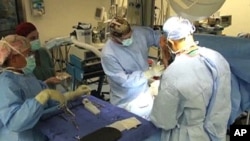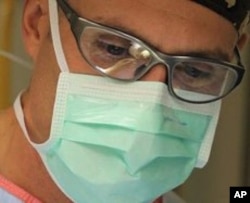Whether a soldier needs a cure for the common cold or brain surgery, the NATO hospital on Kandahar Airfield can handle it. This is one of Afghanistan's most sophisticated hospitals, and it provides top medical care on the front line. Just minutes by helicopter from most conflict spots in the country's south, the hospital saves the lives of 98 percent of the injured who come here.
Recently this hospital's emergency room was filled with the cries of a three-year-old Afghan boy.
The trauma team rushes to their positions, quickly hooking monitors and other equipment to check the boy's vital signs. He is lucky to be alive after stepping on a land mine outside his village. His 10-year-old brother died.
It is a familiar story for the staff of this military hospital on Kandahar Airfield, in Afghanistan's south.
U.S. Navy Commander Michael Danenberg, a doctor who specializes in emergency medicine, estimates 20 to 30 percent of his patients are under the age of 12, and most have severe injuries.
"This is why I signed up with the Navy," Danenberg said. "I've been doing Navy emergency medicine for 19 years now. To me this has been the most fulfilling aspect of my 19-year career so far, the fact that I know I am doing it as close to the time of injury, in a combat zone, and being able to go from there," he said.
The NATO hospital on Kandahar Airfield is one of the most advanced medical facilities in the country. It serves not only international coalition troops and the Afghan military, it also cares for the citizens of this impoverished, war-torn nation.
Despite the war going on not far away, this looks like a hospital transplanted straight out of the United States. The building has the latest medical equipment. A huge air-conditioning system blocks the summer heat out, and helps keep the hospital quiet and clean. Doctors and nurses monitor patients who lie on comfortable beds with white sheets.
It is just minutes by helicopter from most of the region's conflict spots, which means injured soldiers and civilians can reach help as soon as possible. Having an advanced medical facility so close to the front lines saves lives, said U.S Navy Captain Darin Via, the hospital's commanding officer.
"Military medicine has learned over time the closer we can treat any casualty to [the] combat setting, the potential of returning them to their unit is that much greater," said Via. "Obviously in the extreme trauma casualties, the [medical] capabilities closer to combatants saves their lives."
This hospital can treat everything from colds to depression and can handle complex procedures such as brain surgery. But trauma is the specialty.
Doctors see up to 200 severe cases each month, mostly victims of bombs or leftover land mines from earlier conflicts. Chief orthopedic surgeon U.S. Navy Commander Joseph Strauss estimates that more than 85 percent of his patients come directly from the battlefield. That, he said, brings medical challenges that doctors in most hospitals do not face.
"The severity is much higher here, the wounds themselves are significantly contaminated with debris, hay, grass, mud, everything from the terrain that is all over the patient. The wounds are dirty," Strauss said.
But being so close to the battlefield means if a patient makes it to Kandahar alive, chances are he will stay that way. The hospital has a 98 percent survival rate.










